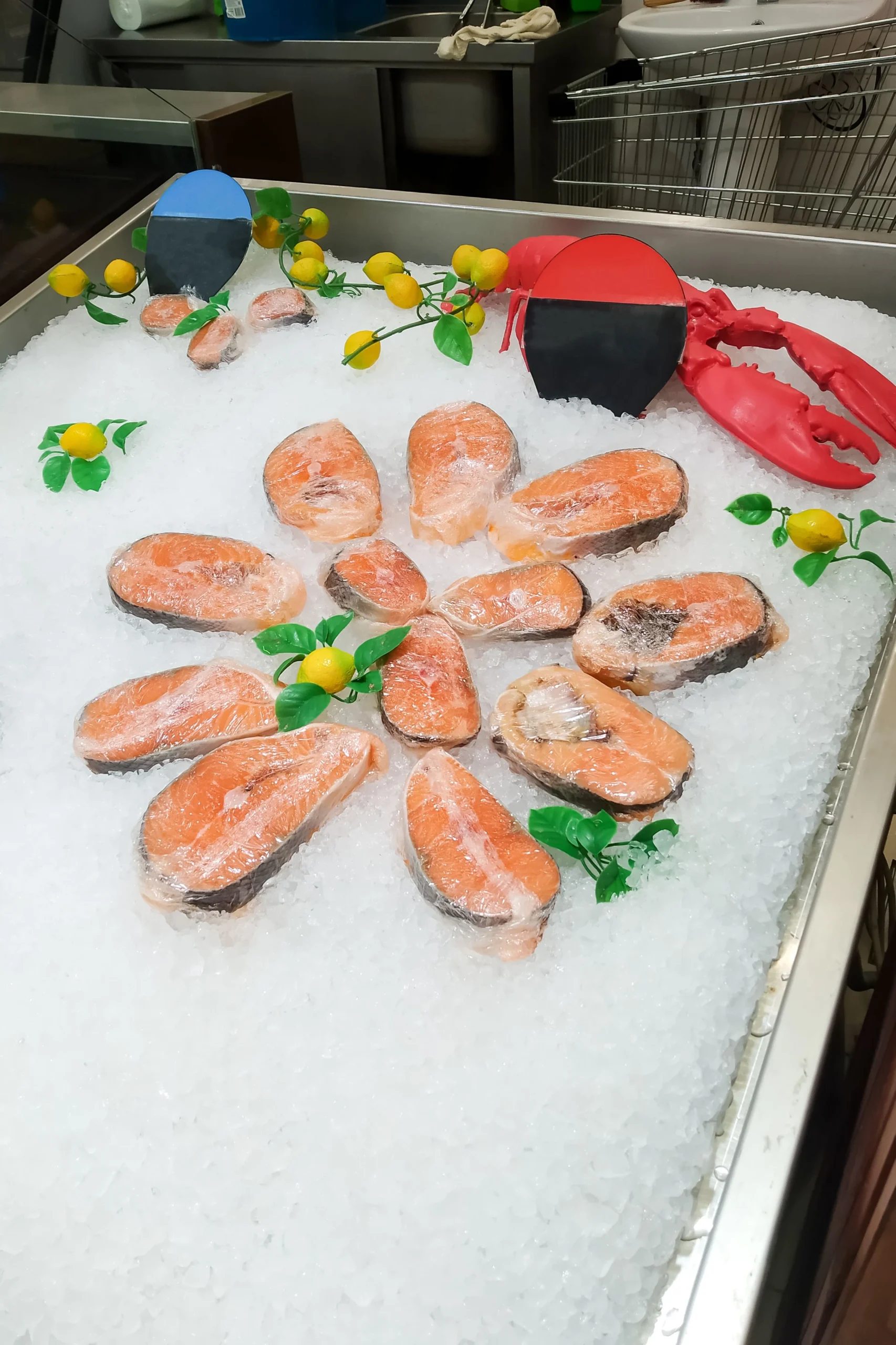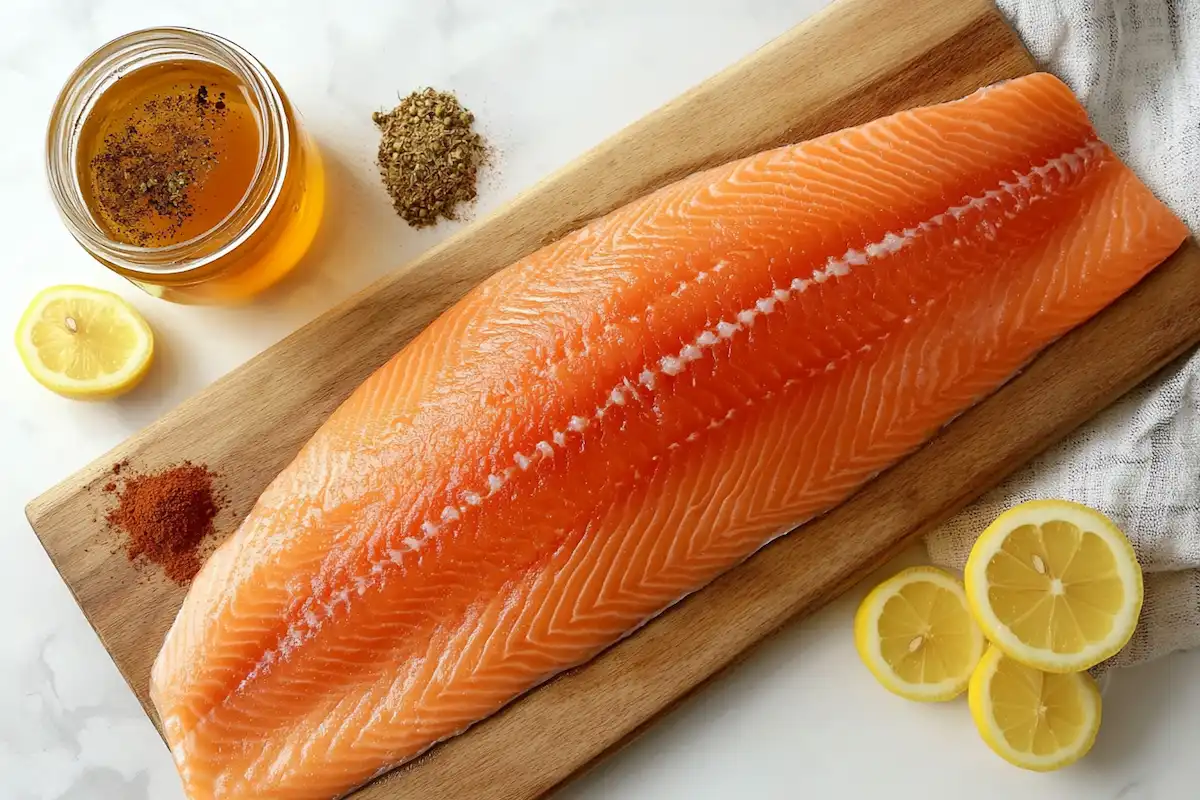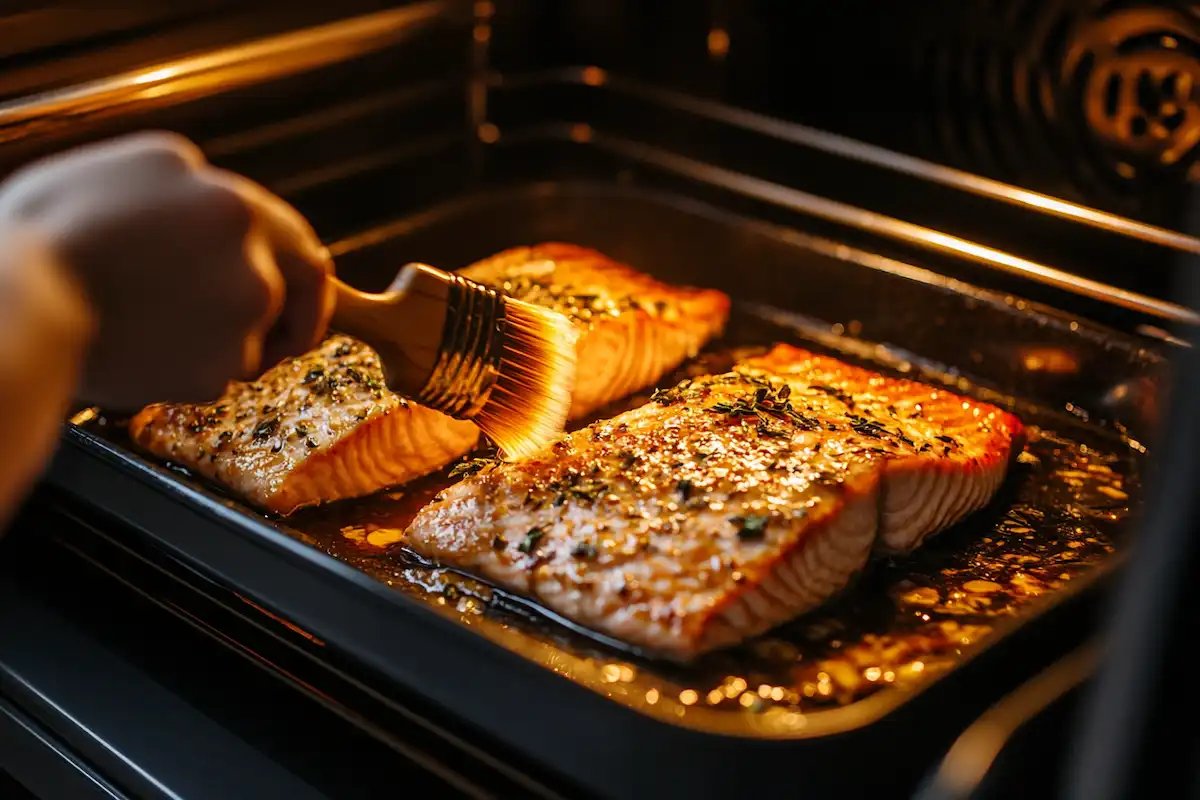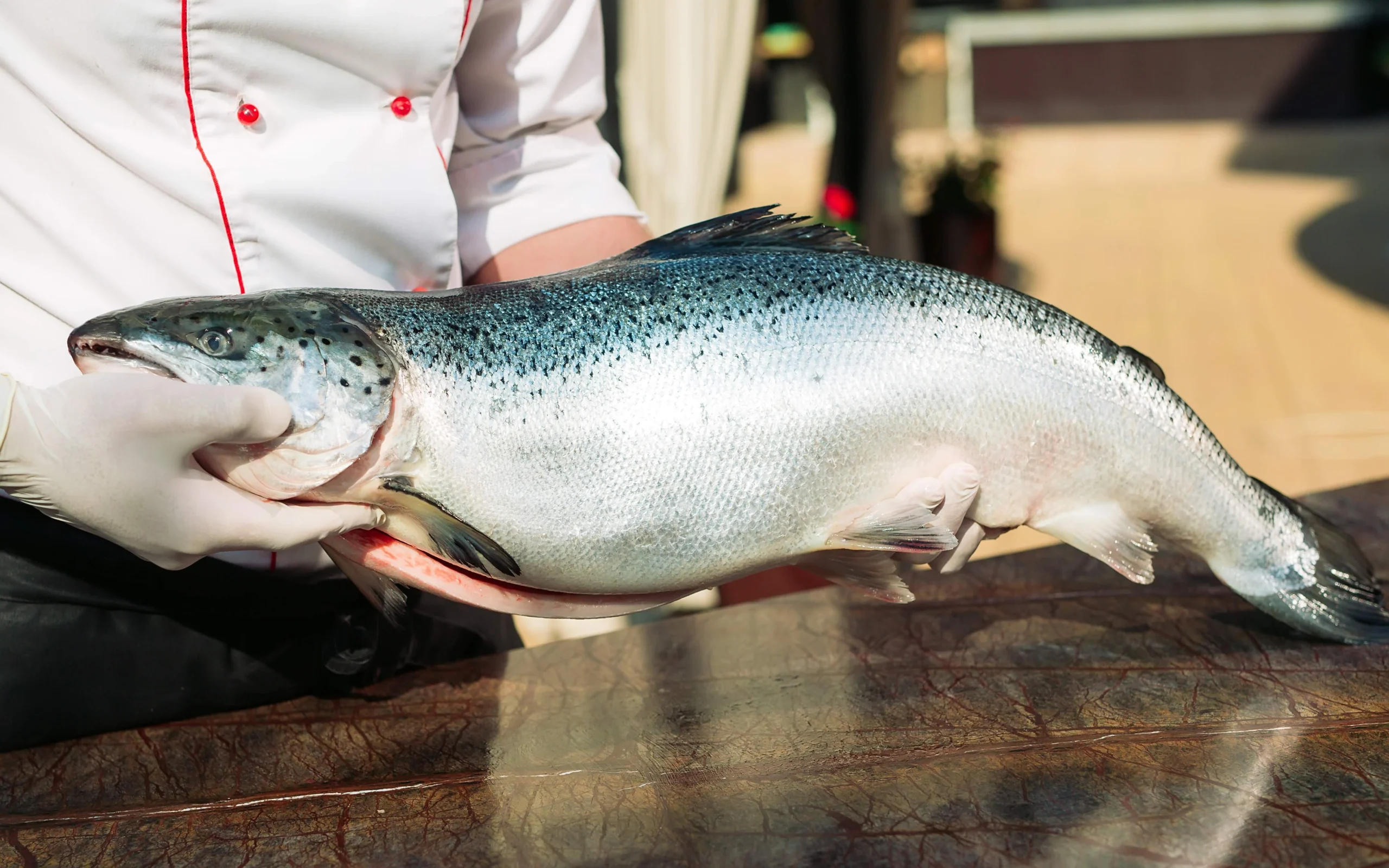This king salmon recipe lands tender fillets on your plate in just 25 minutes—busy-day hero, flavor bomb, total keeper.
Introduction
Our king salmon recipe cooks in 25 minutes, stays ultra-moist, and tastes like a seaside splurge—perfect for easy weeknight dinners.
Meanwhile, let me be real: I’m a broke 19-year-old college kid who needs food that slaps without trashing either my wallet or my schedule. Therefore, when I discovered how buttery-rich king salmon can be ready faster than a bowl of instant ramen, I was instantly hooked. For example, the thicker fillets stay juicy even if you scroll TikTok for a minute too long. However, the best part is the mega-dose of omega-3s that keeps my brain firing through 8 a.m. chem lab.
Beyond pure convenience, roasting king salmon at high heat transforms its silky flesh into fork-tender perfection with barely any effort—no fancy gadgets, no fishy smell, no culinary degree required. Consequently, this recipe has become my go-to move whenever I want something nutritious that still feels like a treat. Stick around and I’ll show you exactly how to nail it (and how to remix leftovers into tomorrow’s breakfast bagel, too).
Table of Contents
Why Choose King Salmon?
Consequently, king (a.k.a. Chinook) boasts the highest natural fat content among all wild salmon species, so it stays melt-in-your-mouth tender instead of drying out. Yet it’s not greasy—just luxuriously rich. A single four-ounce serving delivers over 1,500 mg of heart-happy omega-3s plus hefty hits of vitamin D, selenium, and B-vitamins for lasting energy.
Curious how it stacks up to sockeye or coho? Check my deep-dive on king salmon benefits to geek out on flavor, sustainability, and nutrient stats. Spoiler: Chinook wins on succulence every time.

Ingredient Spotlight
Because fresh fish is the star, we keep the supporting cast short, pantry-friendly, and affordable:
- 2 lb king salmon fillet, skin on, pin bones removed (sub steelhead trout if needed)
- 2 Tbsp olive oil – fruity, not bitter
- 1 Tbsp honey – swap monk-fruit syrup for low-sugar diets
- 1 Tbsp fresh lemon juice – bright citrus zing
- 1 tsp garlic powder – instant savory depth
- ½ tsp smoked paprika – gentle campfire vibe
- ½ tsp sea salt & ¼ tsp black pepper
Sourcing & Substitutions
Therefore, buy wild-caught fillets with tight grain and no dull spots—fresh fish should bounce back when pressed. If it’s out of season or pricey, frozen king salmon works; simply thaw overnight on ice and pat very dry before roasting. Meanwhile, maple syrup sweetens nicely if you’re out of honey, and lime juice swaps seamlessly for lemon.
For more budget-happy salmon spins, peek at my more salmon dishes roundup—those old-fashioned patties taste like childhood comfort for pennies.

Prep & Cook Times
Prep: 10 minutes Cook: 15 minutes Total: 25 minutes
The King Salmon Recipe
Ingredients
- 2 lb king salmon fillet
- 2 Tbsp olive oil
- 1 Tbsp honey
- 1 Tbsp lemon juice
- 1 tsp garlic powder
- ½ tsp smoked paprika
- ½ tsp sea salt
- ¼ tsp black pepper
- Optional garnish: fresh dill, lemon wedges
Step-by-Step Instructions
- Pre-heat & prep. First, pre-heat the oven to 400 °F (205 °C). Line a rimmed baking sheet with parchment and lightly oil it.
- Mix the glaze. Meanwhile, whisk olive oil, honey, lemon juice, garlic powder, paprika, salt, and pepper in a small bowl until syrupy.
- Season the fish. Then pat the salmon dry (key for crispy skin), place it skin-side down, and brush half the glaze over the flesh.
- Roast. Next, bake on the middle rack for 12 minutes. Because king salmon is thick, the center should reach 125 °F (52 °C) for medium-rare and stay blush-pink inside.
- Finish & broil. After that, brush the remaining glaze on top and broil for 1–2 minutes until caramelized. Watch closely; sugar burns fast!
- Rest & serve. Finally, rest 3 minutes, slice cross-wise, garnish with dill, and squeeze extra lemon.

Chef’s Nuggets
Quick rub variation. Swap glaze for dry rub of brown sugar, chili-lime seasoning, and coffee grounds—it’s unexpectedly epic.
Skin that sticks? Therefore, slide a thin fish spatula between skin and parchment—no carnage.
Grill marks craving? For example, sear flesh-side on a ripping-hot grill pan 90 seconds before oven-roasting.
Leftover magic. Meanwhile, cube cooled salmon and toss into rice bowls, leafy salads, or tacos. Trust me, cold salmon tacos slap harder than cafeteria pizza.
Flavor Swaps & Healthy Tweaks
However, palates vary, so here’s how to riff while staying macro-friendly:
| Goal | Swap | Result |
|---|---|---|
| Lower sodium | Replace sea salt with potassium salt; cut by 40 % | Same savory hit, heart-smarter |
| No added sugar | Use allulose syrup or a crushed date | Caramelizes without glycemic spike |
| Bolder spice | Sub chipotle powder for paprika | Smokier heat with mild sweetness |
| Citrus lift | Add grapefruit zest over finished fish | Bright bitterness balances rich fat |
| Sauce it up | Drizzle my zesty seafood sauce | Party vibes and dunk-ability |
Therefore, you can tailor this dish to keto, Whole30, or low-histamine diets by simply tweaking the glaze.
Creative Pairings & Plating
For example, pile flaky salmon atop quinoa speckled with roasted broccoli, or tuck it into a grain bowl with pickled red onions and avocado. Yet it’s also epic on an open-face bagel smeared with dill-speckled cream cheese for brunch. Consequently, check out my morning salmon brunch inspo to flex leftovers like a pro.
Fancy presentation? Slice fillets into thick rectangles, stack them over buttery mashed sweet potatoes, and finish with microgreens for date-night vibes—your roomie will think you secretly work at a Michelin place.

Common Pitfalls & Quick Fixes
- Over-baking dries the fish. Thus, yank it at 125 °F; carry-over heat finishes cooking.
- Flabby skin? Therefore, pat moisture off before seasoning and pre-heat the pan.
- Bland bite. For example, if the glaze tastes too sweet, hit the fish with extra lemon zest after roasting.
- Fishy smell in dorm oven. Consequently, roast atop lemon slices; citrus oils neutralize odor.
- Uneven cooking. Meanwhile, fold thin tail ends under themselves so the fillet thickness matches.
Quick science fix: King salmon’s myoglobin turns opaque at 120–125 °F, so aim there to keep juices locked.
Make-Ahead, Storage & Reheating
- Make-ahead: Season fillet up to 24 h early; keep wrapped on ice in the fridge.
- Fridge life: Store cooked portions in glass containers 3 days max.
- Freezer life: Wrap tightly; freeze for 2 months—label with date like a responsible adult.
- Reheat: Then air-fry at 350 °F (175 °C) for 4 minutes—skin crisps, flesh warms without drying. I definately prefer this over microwaving!
Pro tip: Flake frozen salmon into a skillet of hot rice and veggies; it thaws and reheats simultaneously for an instant stir-fry.
Nutritional Information (per 100 g cooked)
| Calories | Protein | Fat | Carbs | Sodium |
|---|---|---|---|---|
| 240 kcal | 25 g | 15 g | 0 g | 60 mg |
Macros skew protein-forward, fat-rich, and carb-free—ideal for keto or brain-fuel diets.
Conclusion
Therefore, you just mastered a fancy-restaurant meal in under half an hour—high protein, rich flavor, low effort. For example, swap seasonings and sides to keep it fresh all semester and impress anyone who swings by your tiny apartment kitchen. I’d love to hear how you riff on this king salmon recipe—drop your tips, rate the dish, and share a pic in the comments below!
FAQs
What is the best cooking method for King Salmon?
However, quick high-heat roasting (400 °F/205 °C) locks in juices and crisps skin—no flipping drama.
Is King Salmon better than regular salmon?
For example, king’s higher fat equals richer taste and more omega-3s, yet it costs more than coho or sockeye.
What goes well with King Salmon?
Therefore, pair with bright sides like mango salsa, quinoa pilaf, or garlicky green beans.
What are the health benefits of eating King Salmon?
Meanwhile, each serving fuels heart, brain, and vision with EPA/DHA fatty acids plus vitamin D and selenium.

